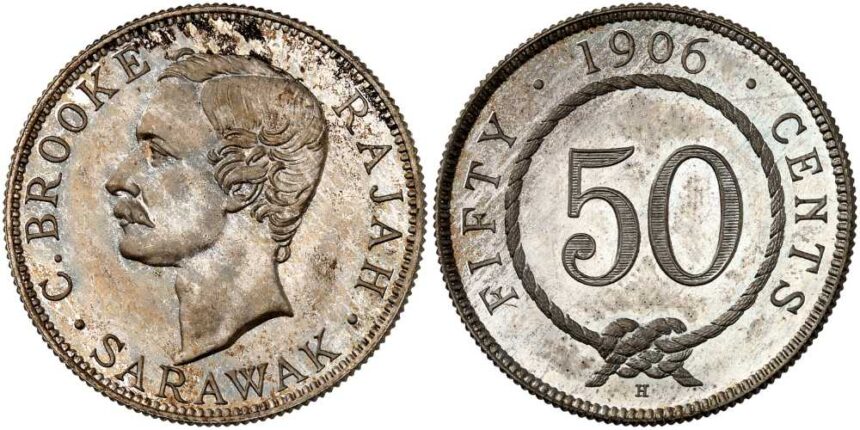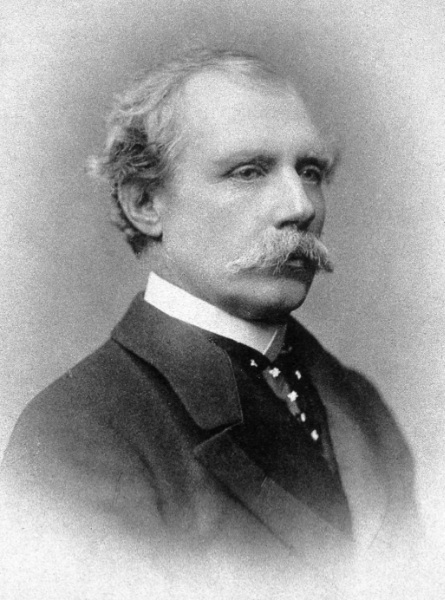Antimony, Borneo and the White Rajahs of Sarawak
It’s the economy, stupid! That’s what the first white Rajah of Sarawak would have said if you had asked him why, as a wealthy man, he chose to settle in the north-west of the island of Borneo, countless nautical miles away from the distractions of London. For there in Sarawak, a silver-grey, brittle and extremely rare semi-metal called antimony was mined, which was highly sought after in Western countries. The press was booming there. It needed type for printing. This type produced a much better print result when 10-30% antimony was added to the raw materials lead and tin. The largest antimony deposit known at the time had been discovered in north-western Borneo around 1823. And since then, the Sultan of Brunei had been fighting with the local governor for control of the mines. British adventurer James Brooke was the one who benefited. He secured control of Sarawak for himself and his descendants. With British support, of course. A coin commemorates the fact that the white rajahs controlled Sarawak for almost a century.

What can be seen on the coin?
Firstly, the special coin offered by Numismatica Genevensis is not the coin itself, but an elaborately produced special edition of the 50 cent piece, known as a ‘specimen’. Such pieces served to show the client what the finished coins would look like. Due to the high quality of the minting, such pieces were occasionally also produced on behalf of collectors. They are the precursors of our current coins produced using the ‘proof’ process. In the case of the Sarawak Specimen, coin collectors were also considered, namely those with political influence. You will find out why later.
The obverse shows the bust of the second Rajah of Sarawak, Charles Antony Johnson Brooke. Because this is too long for us, we will abbreviate his name to Charles Brooke in the following. As was customary at the time, he does not wear any insignia of power on the coin, but is depicted as a fashion-conscious contemporary with only his moustache. The inscription reads C BROOKE RAJAH / SARAWAK.
The reverse side also does without too many details: the value 50 is prominently displayed within a twisted rope that is tied into a knot below the value. This value is also written in Latin letters: FIFTY CENTS. In addition, there is the year 1906 and, very small, an H below the knot, which stands for the Heaton Mint in Birmingham.
Who was Charles Anthony Johnson Brooke?
The handsome young man depicted on the front of the Sarawak 50 cent coin was no longer young at the time of minting, but around 77 years old and had suffered a stroke. At that point, he had been ruling Sarawak for 38 years, but had still not lost his burning ambition.
Charles Anthony was born on 3 June 1829, the son of Reverend Johnson and the younger sister of James Brooke. He served in the Royal Navy for ten years before travelling to Sarawak to join his uncle James. He probably hoped to find a lucrative position. He got it, especially when he managed to motivate the local Dayak to fight alongside him against the Chinese miners. James Brooke had curtailed their rights and sources of income so drastically that he drove them to revolt. Charles Brooke temporarily lifted the ban on headhunting, which was very unpopular with the Dayaks, and used them against the Chinese. Around 2,000 people – men, women and children – are said to have died in the most gruesome conditions. This made such an impression on James Brooke, the childless founder of the dynasty, that he disinherited his brother John and appointed his nephew Charles as his successor.
In the West, Charles Brooke is hardly known for his brutal military campaigns. He is better known for developing the infrastructure of Sarawak. He had roads, water pipes and a railway built. He founded Borneo’s first museum and a school where Malays were taught in the Malay language – at that time not a matter of course, but a pilot project.

Why was the Sarawak 50 cent specimen coin issued in 1906 of all years?
Do not expect to find dollar-sized coins from Sarawak. These were not common in the British colonies of Southeast Asia. Even the Straits Settlements, whose coinage system Sarawak adopted, did not mint any higher denominations. In fact, Charles Brooke only issued 50 cent coins twice during his long reign: in 1900 and 1906.
We can guess why he commissioned a few specimens of the 50 cent coin in 1906, which are extremely rare today: coin collecting was a widespread hobby among the British upper class at the time. Perhaps the Sarawak specimens were intended to attract the attention of influential (coin-collecting!) politicians. Brooke tried to persuade Parliament that the British government should not appoint a resident for the bankrupt Sultanate of Brunei, but should transfer it to him. He failed in this endeavour.
What is the specimen worth 50 Sarawak cents?
The 50-cent coin from 1906 is the rarest of the three 50-cent coins minted by Sarawak under Brookes. Only 10,000 of these coins were ever produced. However, as already mentioned, this is not a normal coin, but a specimen that was produced with particular care. A coin from the same year, but not a specimen, was sold at Heritage in June 2025 in PCGS MS64 condition for $16,000. The last specimen – PCGS SP65 – changed hands at Stacks in October 2023 for $22,000.
The coin offered by NGSA is in better condition than the two comparable coins. We are therefore very excited to see what this lot will fetch.
The catalogues for the Numismatica Genevensis SA auctions can be found on the company’s website. Click here to go to the overview page for all auctions. This link will take you directly to the lot we are presenting.
Text and images: Ursula Kampmann

